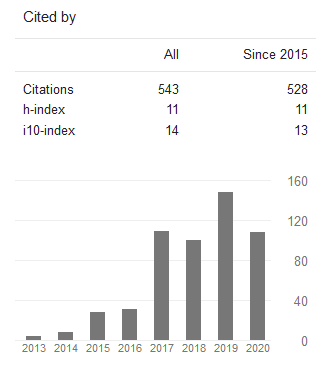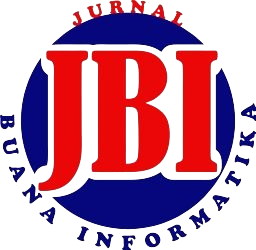Analisis Peranan User Pada Proses SDLC Terhadap Pengembangan Sistem Informasi Perjalanan Dinas
DOI:
https://doi.org/10.24002/jbi.v8i1.1072Abstract
Abstract.
The user involvement in information system development has an important role to develop some systems. The user involvement also has an important role to determine whenever the system is executed properly or not. SDLC is a procedure used to describe a process that occurs during the manufacturing the system. SDLC Process has some phases, they are Project Selection & Planning, Analysis, Design, and Testing & Deployment. The Objective of this study is to understand how much percentage from the user involvement that occur during the information system developing process. The result from this paper is an analysis result from the user involvement that occurs during the information system developing using the SDLC model.
Keywords: Information System, SDLC, User Involvement.
Abstrak.
Peranan dari user terhadap pengembangan sebuah sistem informasi memiliki peranan yang penting dalam proses pembuatan sebuah sistem. Peranan dari user juga menentukan apakah sistem yang dibangun sudah terpenuhi sesuai dengan kebutuhan atau belum. SDLC merupakan sebuah prosedur yang digunakan untuk mendeskripsikan sebuah proses yang terjadi selama pembuatan sebuah sistem. Proses SLDC memiliki beberapa fase seperti Project Selection and Planning, Analysis, Design, dan Testing & Deployment. Tujuan dari penelitian ini adalah mengetahui seberapa besar persentase dari keterlibatan user selama proses pembangunan sistem informasi perjalanan dinas. Hasil dari penelitian ini yaitu berupa sebuah hasil analisis terhadap keterlibatan user dalam proses pembangunan sistem informasi menggunakan model SDLC.
Kata Kunci: Sistem Informasi, SDLC, User Involvement
References
Abbasi, A., Sarker, S., & Chiang, R. H. (2016). Big data research in information systems: Toward an inclusive research agenda. Journal of the Association for Information Systems, 17(2), 3.
Ahmed, Z., Helfrich-Forster, C., & Dandekar, T. (2013). Integrating Formal UML Designs and HCI Patterns with Spiral SDLC in DroLIGHT Implementation. Recent Patents on Computer Science, 6(2), 85-98.
Amlani, R. D. (2012). Advantages and limitations of different SDLC models.International Journal of Computer Applications & Information Technology, 1(3), 6-11.
Butt, S. M., & Ahmad, W. F. W. (2012). Role of User and HCI in Software Development. International Journal of Computer Applications, 58(7).
Butt, S. M., & Ahmad, W. F. W. (2013). The Impact of Intergration HCI in Software Pro-cessing Models. International Journal of Scientific & Engineering Research, 4(5), 175-177.
Conger, S. (2010). Software development life cycles and methodologies: Fixing the old and adopting the new.
Hasnine, M. N., Chayon, M. K. H., & Rahman, M. M. (2015). A Cost Effective Approach to Develop Mid-size Enterprise Software Adopted the Waterfall Model. World Academy of Science, Engineering and Technology, International Journal of Computer, Electrical, Automation, Control and Information Engineering, 9(5), 1140-1149.
Majid, R. A., Noor, N. L. M., Adnan, W. A. W., & Mansor, S. (2010, November). A survey on user involvement in software development life cycle from practitioner's perspectives. In Computer Sciences and Convergence Information Technology (ICCIT), 2010 5th International Conference on (pp. 240-243). IEEE.
Pollard, C. E., Gupta, D., & Satzinger, J. W. (2010). Teaching systems development: a compelling case for integrating the SDLC with the ITSM lifecycle. Information Systems Management, 27(2), 113-122.
Ragunath, P. K., Velmourougan, S., Davachelvan, P., Kayalvizhi, S., & Ravimohan, R. (2010). Evolving a new model (SDLC Model-2010) for software development life cycle (SDLC). International Journal of Computer Science and Network Security, 10(1), 112-119.
Downloads
Published
Issue
Section
License
Copyright of this journal is assigned to Jurnal Buana Informatika as the journal publisher by the knowledge of author, whilst the moral right of the publication belongs to author. Every printed and electronic publications are open access for educational purposes, research, and library. The editorial board is not responsible for copyright violation to the other than them aims mentioned before. The reproduction of any part of this journal (printed or online) will be allowed only with a written permission from Jurnal Buana Informatika.
This work is licensed under a Creative Commons Attribution-ShareAlike 4.0 International License.









